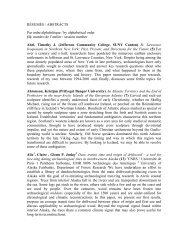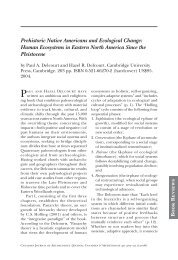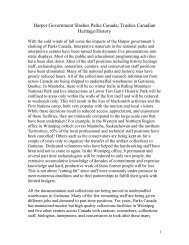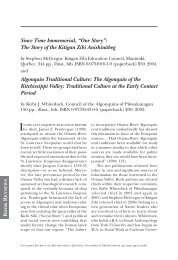16 - 20 MAI MAY 16 - 20 - Canadian Archaeological Association
16 - 20 MAI MAY 16 - 20 - Canadian Archaeological Association
16 - 20 MAI MAY 16 - 20 - Canadian Archaeological Association
You also want an ePaper? Increase the reach of your titles
YUMPU automatically turns print PDFs into web optimized ePapers that Google loves.
Transcanadienne. Bien que le complexe Turcot soit constitué presque<br />
essentiellement de voies aériennes, le ministère des Transports du<br />
Québec prévoit de revoir sa configuration, ce qui pourrait avoir un<br />
impact sur les biens archéologiques potentiellement présents dans le<br />
sol. En ce qui concerne l’archéologie, une approche méthodologique<br />
spécifique à ce type de projet est donc essentielle afin de planifier les<br />
interventions archéologiques nécessaires.<br />
At the moment, the Turcot interchange is almost entirely an aerial<br />
highway. It’s reconfiguration, by the ministry of Transports of Québec,<br />
could have an impact on the archaeological sites potentially buried<br />
within the ground of the future highway layout. From an archaeological<br />
point of view, a methodological approach specific to this type of<br />
project is required to plan the archaeological interventions needed.<br />
Duchaine, Désirée-Emmanuelle (Ruralys) • Wolfe’s Cove Hill: un<br />
point stratégique pour l’armée britannique lors des batailles de 1759<br />
et 1760 [12]<br />
Au cours de l’été et de l’automne <strong>20</strong>11, des fouilles archéologiques<br />
ont été réalisées sur les sites du musée du Québec (CeEt-542) et<br />
du couvent Saint-Dominique (CeEt-893) dans le cadre du projet<br />
d’agrandissement du Musée national des beaux-arts du Québec. Les<br />
interventions archéologiques sur le site du musée du Québec ont permis<br />
de mettre au jour des témoins importants de l’histoire de la ville<br />
de Québec. Une sépulture d’un militaire ainsi que des vestiges en bois<br />
respectivement associés aux batailles des Plaines (1759) et de Sainte-<br />
Foy (1760) jettent un nouveau regard sur ces événements décisifs<br />
dans l’histoire de Québec. Les fouilles archéologiques sur le site du<br />
couvent Saint-Dominique ont conduit à la découverte des fondations<br />
de la villa Battlefield Cottage construite en 1829. Un autre témoin significatif<br />
de la vie bourgeoise de la ville de Québec.<br />
Duggan, Rebecca (Parks Canada) • The Louisbourg coastal conservation<br />
plan [<strong>16</strong>]<br />
A coastal conservation plan is currently in development for the management<br />
of eroding heritage at the Fortress of Louisbourg. A peer-reviewed<br />
draft conservation plan has been produced, drawing together<br />
information about coastal geomorphology, coastally-positioned heritage<br />
sites, erosion rates, and anticipated coastal change at Louisbourg<br />
based on the IPCC’s fourth assessment report predictions for sea level<br />
rise over the next century. The conservation plan divides the Louisbourg<br />
coastline into management units according to natural coastal<br />
cell divisions. Within each cell, the future outlook for heritage site<br />
protection is to be assessed through a coastal ‘triage’ process. This<br />
is proving to be a complex task with numerous variables to consider<br />
such as heritage value, protection vs. rescue options, financial viability,<br />
research potential, and public engagement options. This paper<br />
will discuss current efforts to work through the triage process, to best<br />
meet resource management needs now & in the years to come.<br />
Duguay, Françoise (Célat, Université Laval) • Clay Pipes in New<br />
France, <strong>16</strong>25-1760: Can Archaeometry be Helpful in Identifying Imitations<br />
[21]<br />
A small number of clay pipe bowls from collections housed in the<br />
Netherlands and the United Kingdom were submitted to neutron<br />
activation, to be used as reference samples. Pipe fragments from an<br />
archaeological site in Trois-Rivières (Canada), presenting unusual<br />
features (identified through macroscopic and microscopic observations),<br />
were also submitted to the same procedure. Comparisons of<br />
results tend to support the impression gained from qualitative characterisation,<br />
that pipes used in New France were mainly imports from<br />
the Netherlands. However, minute chemical component differences<br />
with both the Netherlands and UK pipes, combined with visual characterisation,<br />
lead to another conclusion: some pipes might be imitations<br />
of Dutch products. Where were they made? We propose that<br />
imitations used in New France originated from continental Europe,<br />
perhaps France, since the observed chemical components offer greater<br />
similarity with the Netherlands’ sample than the UK one. Warning:<br />
given the small number of artefacts and samples, the archaeometric<br />
findings shouldn’t be regarded as definitive.<br />
Duguay, Françoise (CÉLAT, Université Laval) • Tadoussac et Trois-<br />
Rivières : deux hauts lieux de la traite des fourrures (fin XVI e – tournant<br />
XVIII e siècle) [29]<br />
L’observation d’une ressemblance des lieux physiques, entre Tadous-<br />
sac et Trois Rivières, a initié une réflexion par rapport à leur statut<br />
prépondérant dans la traite des fourrures. La synthèse des données<br />
biophysiques, ethnohistoriques et historiques établit des points de<br />
comparaison, afin d’identifier des variables qui orientent le sens<br />
de diverses manifestations, notamment l’instauration de postes de<br />
traite. L’étude met en exergue l’importance des deux lieux pour les<br />
populations amérindiennes, notamment algonquiennes, facteur qui<br />
semble avoir eu une incidence pour déterminer leur statut dans le<br />
commerce des fourrures. On remarque, par ailleurs, une dichotomie<br />
dans l’historiographie relative aux deux endroits, quant à la place accordée<br />
aux Amérindiens et au commerce.<br />
Dunlop, John 1 , Dan Kellogg 2 and Blake Williams 2 ( 1 <strong>Archaeological</strong><br />
Services Inc., University of Western Ontario; 2 <strong>Archaeological</strong><br />
Services Inc.) • Geophysical Survey Applications to the CRM Industry<br />
in Southern Ontario: Case studies of success at three sites in southern<br />
Ontario [31]<br />
Geophysical surveying is a non-destructive surveying technique that<br />
is currently regulated as an optional activity during site-specific investigations<br />
in the CRM industry in Ontario. As such, these applications<br />
have little bearing on the regulated process of CRM archaeology.<br />
An examination of geophysical surveys undertaken by <strong>Archaeological</strong><br />
Services Inc. at three sites: the Fort York National Historic site-<br />
Government House Area (AjGu-28), the Damiani Site (AlGv-231), and<br />
Blacker’s Brickworks (AgHb-415), resulted in positive identification<br />
of subsurface archaeological deposits, which guided the excavation<br />
and interpretation of the sites. The results indicate that geophysics<br />
can be effectively used in the assessment process to assist in refining<br />
investigative strategies to sites, the result of which would be greater<br />
efficiency in areas such as project budgeting and site conservation.<br />
Dunning, Phil (Parks Canada) • Yeoman and Merchant: Clothing and<br />
Accessories from the Elisabeth and Mary, a <strong>16</strong>90 New England Shipwreck<br />
[9]<br />
The year <strong>16</strong>89 saw the beginning of King William’s War, between<br />
France and an alliance of England, Spain and Holland. In <strong>16</strong>90 the<br />
New Englanders launched a naval expedition to take Quebec City, the<br />
capital of New France. The attack failed, and on the return voyage<br />
the fleet encountered violent storms in the St. Lawrence River. Four<br />
ships were lost, including the Elizabeth and Mary, carrying members<br />
of the Dorchester, Massachusetts militia. Parks Canada’s underwater<br />
archaeologists excavated the wreck, and the recoveries include footwear,<br />
buttons, textiles, ribbons, buckles and jewellery. These accessories<br />
and articles of clothing represent a microcosm of Dorchester<br />
society, from yeoman to merchant, from kersey to broadcloth, from<br />
pewter to silver.<br />
Dussault, Frédéric (Université Laval) • Reconciling past perceptions:<br />
Explorers to Northwest Greenland and Inughuit hygiene [10]<br />
While initially “discovered” by the explorer John Ross in 1818, the<br />
Polar Inuit also achieved certain recognition for helping Robert Peary<br />
reach the North Pole. Explorers’ accounts attracted the interest of<br />
anthropologists, such as Knud Rasmussen and Erik Holtved, who<br />
sought to understand the essence of Inughuit life by cataloguing their<br />
myths and legends as well as observing them in daily life. Following<br />
their expeditions in Greenland, explorers and anthropologist, related<br />
conflicting details about Inughuit cultural practices, such as hygiene.<br />
By observing the spatial distribution of ectoparasites found in different<br />
activity areas of four sod houses, we were able to infer hygienic<br />
practices described in the Inughuit oral tradition. Through interdisciplinary<br />
analysis of archaeoentomological evidence, oral traditions<br />
and material culture associated with the Polar Inuit, we propose a<br />
different narrative of past hygienic practices of Greenland’s Northwest<br />
coast.<br />
Duval, Isabelle (Université du Québec à Chicoutimi) • Analyse de<br />
provenance sur un gorgerin avec la micro-XRF [31]<br />
Une caractérisation géochimique, de manière non destructive par micro-XRF,<br />
a été réalisée sur un fragment de gorgerin en pierre retrouvé<br />
sur le site Cartier-Roberval (CeEu-4). Les données d’analyses ont<br />
permis d’associer la pierre du gorgerin avec une carrière de pierre<br />
décorative de grès rouge datant de la fin du 19 e siècle dans le Bas-<br />
Saint-Laurent. La compréhension du contexte géologique permet de<br />
suggérer des lieux accessibles pouvant avoir été exploités à la préhistoire.<br />
Les gorgerins sont des objets polis rares qui apportent des in-<br />
38








